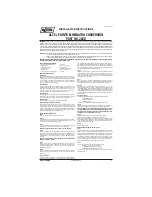
Your GM dealer/retailer will know the kind of wheel
you need.
Each new wheel should have the same load-carrying
capacity, diameter, width, offset and be mounted the
same way as the one it replaces.
If you need to replace any of your wheels, wheel bolts,
wheel nuts, or Tire Pressure Monitor System (TPMS)
sensors, replace them only with new GM original
equipment parts. This way, you will be sure to have the
right wheel, wheel bolts, wheel nuts, and TPMS sensors
for your vehicle.
{
CAUTION:
Using the wrong replacement wheels, wheel bolts,
or wheel nuts on your vehicle can be dangerous.
It could affect the braking and handling of your
vehicle, make your tires lose air and make you
CAUTION:
(Continued)
CAUTION:
(Continued)
lose control. You could have a collision in which
you or others could be injured. Always use the
correct wheel, wheel bolts, and wheel nuts for
replacement.
Notice: The wrong wheel can also cause problems
with bearing life, brake cooling, speedometer or
odometer calibration, headlamp aim, bumper height,
vehicle ground clearance, and tire or tire chain
clearance to the body and chassis.
If your vehicle is a professional model, the wheels have
a unique offset and bolt hole diameter. Each of the
wheels on the professional vehicle have eight wheels
nuts. The wheels on the non-professional vehicle
have five wheel nuts. See Changing a Flat Tire on
page 5-74 for more information.
5-72
Summary of Contents for 2009 DTS
Page 18: ...Put someone on it Get it up to speed Then stop the vehicle The rider does not stop 1 14...
Page 76: ...NOTES 1 72...
Page 143: ...NOTES 3 3...
Page 144: ...Instrument Panel Overview Console Shift Model shown Column Shift Model similar 3 4...
Page 270: ...NOTES 3 130...
Page 408: ...NOTES 5 104...
Page 422: ...Engine Drive Belt Routing 4 6L V8 Engines 6 14...
Page 446: ...NOTES 7 20...
















































